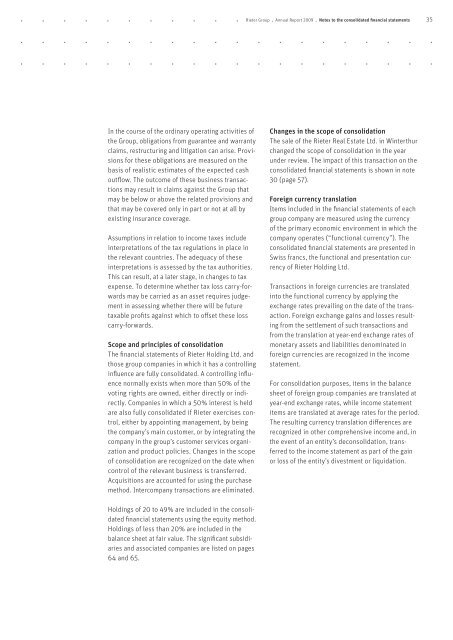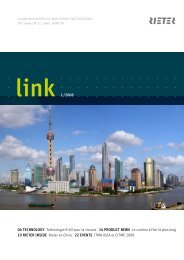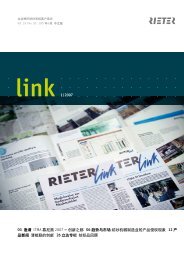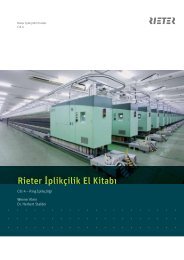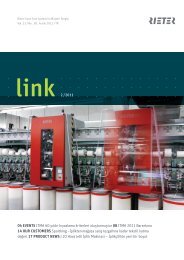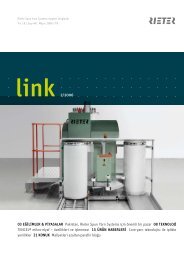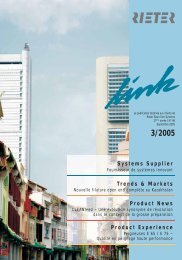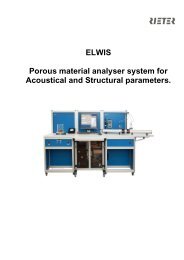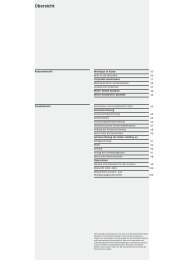Annual Report 2009 - Rieter
Annual Report 2009 - Rieter
Annual Report 2009 - Rieter
You also want an ePaper? Increase the reach of your titles
YUMPU automatically turns print PDFs into web optimized ePapers that Google loves.
In the course of the ordinary operating activities of<br />
the Group, obligations from guarantee and warranty<br />
claims, restructuring and litigation can arise. Provisions<br />
for these obligations are measured on the<br />
basis of realistic estimates of the expected cash<br />
outflow. The outcome of these business transactions<br />
may result in claims against the Group that<br />
may be below or above the related provisions and<br />
that may be covered only in part or not at all by<br />
existing insurance coverage.<br />
Assumptions in relation to income taxes include<br />
interpretations of the tax regulations in place in<br />
the relevant countries. The adequacy of these<br />
interpretations is assessed by the tax authorities.<br />
This can result, at a later stage, in changes to tax<br />
expense. To determine whether tax loss carry-forwards<br />
may be carried as an asset requires judgement<br />
in assessing whether there will be future<br />
taxable profits against which to offset these loss<br />
carry-forwards.<br />
Scope and principles of consolidation<br />
The financial statements of <strong>Rieter</strong> Holding Ltd. and<br />
those group companies in which it has a controlling<br />
influence are fully consolidated. A controlling influence<br />
normally exists when more than 50% of the<br />
voting rights are owned, either directly or indirectly.<br />
Companies in which a 50% interest is held<br />
are also fully consolidated if <strong>Rieter</strong> exercises control,<br />
either by appointing management, by being<br />
the com pany’s main customer, or by integrating the<br />
company in the group’s customer services organization<br />
and product policies. Changes in the scope<br />
of consolidation are recognized on the date when<br />
control of the relevant business is transferred.<br />
Acquisitions are accounted for using the purchase<br />
method. Intercompany transactions are eliminated.<br />
Holdings of 20 to 49% are included in the consolidated<br />
financial statements using the equity method.<br />
Holdings of less than 20% are included in the<br />
balance sheet at fair value. The significant subsidiaries<br />
and associated companies are listed on pages<br />
64 and 65.<br />
<strong>Rieter</strong> Group . <strong>Annual</strong> <strong>Report</strong> <strong>2009</strong> . Notes to the consolidated financial statements<br />
Changes in the scope of consolidation<br />
The sale of the <strong>Rieter</strong> Real Estate Ltd. in Winterthur<br />
changed the scope of consolidation in the year<br />
under review. The impact of this transaction on the<br />
consolidated financial statements is shown in note<br />
30 (page 57).<br />
Foreign currency translation<br />
Items included in the financial statements of each<br />
group company are measured using the currency<br />
of the primary economic environment in which the<br />
company operates (“functional currency”). The<br />
consolidated financial statements are presented in<br />
Swiss francs, the functional and presentation currency<br />
of <strong>Rieter</strong> Holding Ltd.<br />
Transactions in foreign currencies are translated<br />
into the functional currency by applying the<br />
exchange rates prevailing on the date of the transaction.<br />
Foreign exchange gains and losses resulting<br />
from the settlement of such transactions and<br />
from the translation at year-end exchange rates of<br />
monetary assets and liabilities denominated in<br />
foreign currencies are recognized in the income<br />
statement.<br />
For consolidation purposes, items in the balance<br />
sheet of foreign group companies are translated at<br />
year-end exchange rates, while income statement<br />
items are translated at average rates for the period.<br />
The resulting currency translation differences are<br />
recognized in other comprehensive income and, in<br />
the event of an entity’s deconsolidation, transferred<br />
to the income statement as part of the gain<br />
or loss of the entity’s divestment or liquidation.<br />
35


